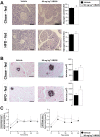Glycogen phosphorylase inhibition improves beta cell function
- PMID: 28409826
- PMCID: PMC5758390
- DOI: 10.1111/bph.13819
Glycogen phosphorylase inhibition improves beta cell function
Abstract
Background and purpose: Glycogen phosphorylase (GP) is the key enzyme for glycogen degradation. GP inhibitors (GPi-s) are glucose lowering agents that cause the accumulation of glucose in the liver as glycogen. Glycogen metabolism has implications in beta cell function. Glycogen degradation can maintain cellular glucose levels, which feeds into catabolism to maintain insulin secretion, and elevated glycogen degradation levels contribute to glucotoxicity. The purpose of this study was to assess whether influencing glycogen metabolism in beta cells by GPi-s affects the function of these cells.
Experimental approach: The effects of structurally different GPi-s were investigated on MIN6 insulinoma cells and in a mouse model of diabetes.
Key results: GPi treatment increased glycogen content and, consequently, the surface area of glycogen in MIN6 cells. Furthermore, GPi treatment induced insulin receptor β (InsRβ), Akt and p70S6K phosphorylation, as well as pancreatic and duodenal homeobox 1(PDX1) and insulin expression. In line with these findings, GPi-s enhanced non-stimulated and glucose-stimulated insulin secretion in MIN6 cells. The InsRβ was shown to co-localize with glycogen particles as confirmed by in silico screening, where components of InsR signalling were identified as glycogen-bound proteins. GPi-s also activated the pathway of insulin secretion, indicated by enhanced glycolysis, mitochondrial oxidation and calcium signalling. Finally, GPi-s increased the size of islets of Langerhans and improved glucose-induced insulin release in mice.
Conclusion and implications: These data suggest that GPi-s also target beta cells and can be repurposed as agents to preserve beta cell function or even ameliorate beta cell dysfunction in different forms of diabetes.
Linked articles: This article is part of a themed section on Inventing New Therapies Without Reinventing the Wheel: The Power of Drug Repurposing. To view the other articles in this section visit http://onlinelibrary.wiley.com/doi/10.1111/bph.v175.2/issuetoc.
© 2017 The British Pharmacological Society.
Figures







Similar articles
-
Glycogen phosphorylase inhibitor, 2,3-bis[(2E)-3-(4-hydroxyphenyl)prop-2-enamido] butanedioic acid (BF142), improves baseline insulin secretion of MIN6 insulinoma cells.PLoS One. 2020 Sep 22;15(9):e0236081. doi: 10.1371/journal.pone.0236081. eCollection 2020. PLoS One. 2020. PMID: 32960890 Free PMC article.
-
Maslinic acid modulates glycogen metabolism by enhancing the insulin signaling pathway and inhibiting glycogen phosphorylase.Chin J Nat Med. 2014 Apr;12(4):259-65. doi: 10.1016/S1875-5364(14)60052-2. Chin J Nat Med. 2014. PMID: 24863350
-
The experimental type 2 diabetes therapy glycogen phosphorylase inhibition can impair aerobic muscle function during prolonged contraction.Diabetes. 2006 Jun;55(6):1855-61. doi: 10.2337/db05-1687. Diabetes. 2006. PMID: 16731853
-
Mitochondrial ion channels in pancreatic β-cells: Novel pharmacological targets for the treatment of Type 2 diabetes.Br J Pharmacol. 2021 May;178(10):2077-2095. doi: 10.1111/bph.15018. Epub 2020 Mar 21. Br J Pharmacol. 2021. PMID: 32056196 Free PMC article. Review.
-
Mitochondria and diabetes. Genetic, biochemical, and clinical implications of the cellular energy circuit.Diabetes. 1996 Feb;45(2):113-26. doi: 10.2337/diab.45.2.113. Diabetes. 1996. PMID: 8549853 Review.
Cited by
-
Inventing new therapies without reinventing the wheel: the power of drug repurposing.Br J Pharmacol. 2018 Jan;175(2):165-167. doi: 10.1111/bph.14081. Br J Pharmacol. 2018. PMID: 29313889 Free PMC article.
-
Carbonic Anhydrase Inhibitor Acetazolamide Enhances CHOP Treatment Response and Stimulates Effector T-Cell Infiltration in A20/BalbC Murine B-Cell Lymphoma.Int J Mol Sci. 2020 Jul 15;21(14):5001. doi: 10.3390/ijms21145001. Int J Mol Sci. 2020. PMID: 32679833 Free PMC article.
-
Synthesis of New C- and N-β-d-Glucopyranosyl Derivatives of Imidazole, 1,2,3-Triazole and Tetrazole, and Their Evaluation as Inhibitors of Glycogen Phosphorylase.Molecules. 2018 Mar 15;23(3):666. doi: 10.3390/molecules23030666. Molecules. 2018. PMID: 29543771 Free PMC article.
-
Metabolic impacts of cordycepin on hepatic proteomic expression in streptozotocin-induced type 1 diabetic mice.PLoS One. 2021 Aug 13;16(8):e0256140. doi: 10.1371/journal.pone.0256140. eCollection 2021. PLoS One. 2021. PMID: 34388207 Free PMC article.
-
A pre-clinical study to investigate the anti-diabetic potential of p-propoxybenzoic acid as a multi-target inhibitor in streptozotocin-nicotinamide induced type-2 diabetic rats.J Diabetes Metab Disord. 2022 Dec 31;22(1):571-580. doi: 10.1007/s40200-022-01177-y. eCollection 2023 Jun. J Diabetes Metab Disord. 2022. PMID: 37255789 Free PMC article.
References
-
- Abdul‐Ghani MA (2013). Type 2 diabetes and the evolving paradigm in glucose regulation. The American journal of managed care 19: S43–50. - PubMed
-
- Agius L (2007). New hepatic targets for glycaemic control in diabetes. Best Pract Res Clin Endocrinol Metab 21: 587–605. - PubMed
-
- Agius L (2015). Role of glycogen phosphorylase in liver glycogen metabolism. Mol Aspects Med 46: 34–45. - PubMed
Publication types
MeSH terms
Substances
LinkOut - more resources
Full Text Sources
Other Literature Sources
Research Materials
Miscellaneous

